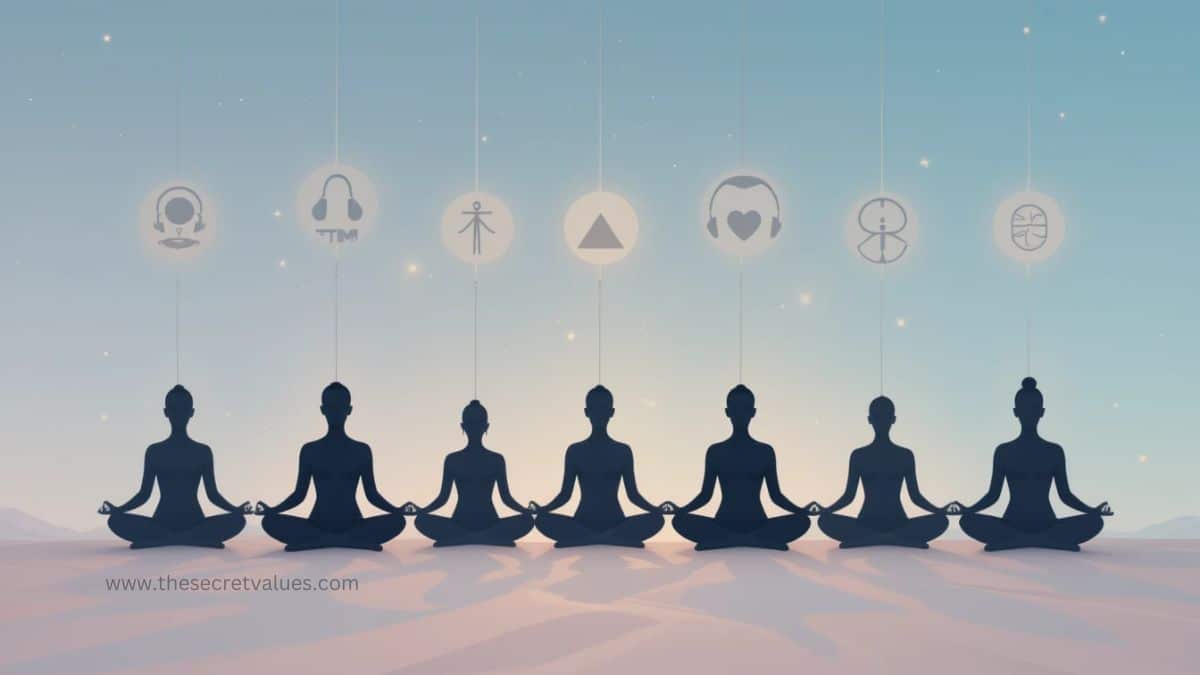Hoy, dost! Life in 2025 is a Bollywood movie that never stops – drama, deadlines and dhoom-dhaam. It is as though living in today’s world is akin to attempting to find a needle in a haystack, trying to find calm in between our demands at work, at home, and on the phone. However, never mind, yaar! Mindfulness is your excellent navigator towards being calm, centred, and joyful, regardless of how frantic the situations may be. In this blog, we’re diving into the Top 10 Mindfulness Techniques for Daily Calmness in 2025 – simple, practical, and desi-friendly ways to bring some shanti into your life.
These mindfulness techniques for daily calmness are designed to fit into your busy routine, whether you’re sipping chai in the morning or stuck in traffic. They are scientific, easy to relate to and full of the Indian touch of comfort and knowledge. Okay then, we begin, ekdum jhakaas!
The importance of Mindfulness in 2025
Now that we have context, let’s discuss why Mindfulness is so significant. In today’s society, stress can be likened to that unwelcome visitor who never seems to leave. Whether due to increased work pressure or our constant social media overload, our minds are under constant overdrive. A 2024 study published by the Indian Journal of Psychiatry shows that more than 40 per cent of urban Indians experience chronic stress and anxiety. Many of us are overwhelmed, aren’t we?
Mindfulness involves being in the state of the immediate present and being keenly aware of what appears, without judgment. It’s just putting life on hold and saying, ‘Bas, itna hi abhi ke liye hai.’ By practising daily mindfulness tips, you can reduce stress, improve focus, and even sleep better. Plus, it’s not about sitting cross-legged for hours – these easy mindfulness practices are perfect for our fast-paced desi lifestyle.
1. Home Morning Mindfulness Routine: Gratitude Morning Chai Practice
There is no more appropriate thing to say Good Morning, India than a hot cup of chai. And we shall make this an everyday thing into a mindfulness ritual.
That is how to do it:
Step 1: When you brew tea, do it and pay attention to your chai —the sound of the boiling water, the smell of cardamom, and the feel of the cup.
Step 2: Go to a secluded corner, close your eyes and think of three things that you are thankful for today. It may be your family, sunshine day or even that proper chai!
Step 3: Take a sip at a time and enjoy the flavour. Instead of jotting down your best to-do list, relax your mind about the instant.
Why it works:
Morning home mindfulness allows us to establish a good vibe to carry out the rest of the day. According to a 2023 study in Frontiers in Psychology, gratitude rewires the brain, making it better able to spot the good things and decreasing stress hormones. Also, it is as Indian as it can be!
Pro Tip: Keep a gratitude jonearby.nearby Create a checklist of your three things, either daily or weekly; it’s a game-changer for developing mindfulness habits.
2. Deep Breathing: The 4-4-4 Technique for Instant Calm
When life feels like a Mumbai local at peak hours, deep breathing is your ticket to calm. The 4-4-4 technique is not complicated; it can be done everywhere, at the workplace, at home or even at a family gathering.
How To Do It:
Breathe in via the nose for 4 seconds.
Breathe in and out without a gasp for 4 seconds.
Expel the air through your mouth at a count of 4 seconds.
Say this 5 times, concentrating on your breath.
The Reason it Works:
Deep breathing activates the parasympathetic nervous system, lowering cortisol levels (the stress hormone). It is one of the fastest mindfulness exercises for busy individuals and only lasts one minute.
Desi Twist: Try to imagine yourself in the cool morning air on top of the Himalayas nd blowing out all the stress. Wonders are happening like magic, bhai!
3. Mindful Eating: Your Dal-Chawal is Never Tasted Better
Food is love in India, yet we run and eat. Mindful eating involves taking your time and savouring each bite, utilising meals as a stress-reducing mindfulness practice.
How to Do:
Step 1: Have a sitting meal without distractions; no phone and TV.
Step 2: Observe the colour of the sabzi and the texture of the roti.
Step 3: Bite a little and chew thoroughly, and enjoy the flavours. Pose this question to yourself: How does it taste? What is it like?”
Step 4: Thanks to the meal, silently, without words, to the farmer or the cook, or your mum and her magic hands.
The Reason that works:
According to a 2024 Nutrition Journal study, mindful eating suppresses overeating behaviours and enhances digestion, as it relaxes the nervous system. It is a natural form of calming down the mind and makes each meal an individual small meditation.
Pro Tip: Pair this with your favourite comfort food and finish with a prayer on rajma-chawal or dosa. It is heavenly delicious!
4. Quick Stress-Busting: The 5-Minute Body Scan
Feeling tense? Body scan is a simple meditation practice that allows you to become aware of your body and reduce stress. It’s ideal whenever you’re waiting in traffic or before a meeting.
How To Do It:
Adjust yourself to a comfortable sitting or lying position.
Put your hands on your lap, shut your eyes tightly, and breathe deeply.
Pay attention to every single part of your body, starting with your toes and moving up to your head. Pay attention to tense or warm feelings or senses.
When your mind becomes distracted, guide it back to the part of the body you are concentrating on.
Take 5 minutes to do so.
The reasons why it works are as follows:
This stress-reducing practice of Mindfulness improves your Mindfulness and enables you to recognise the signs. There is scientific evidence in support of this: a study published in the Mindfulness Journal revealed that anxiety decreased by 25%% during a single body scan session.
Desi Hack: Visualise a great wave of relaxation inside you, just like the Ganga passing through your body to clean up the stress.
5. Mindful Walking: Turn Your Night Walk into Meditation
Do you enjoy night strolls in the park or your colony? Enforce a calm mind routine for them.
How to Do it:
Take your time and be conscious of every step you take; notice how your foot falls on the ground and practice regulated breathing.
Look around you, charms, he says, the singing of birds or the whisper of the leaves, or the noise of the street peddlers.
When your thoughts wander to something you’re worried about, come to the feeling of walking gently.
The Reason This Works:
According to research published in the Journal of Behavioural Medicine, walking meditation enhances attention. It minimises nervousness, allowing individuals to remain calm and focused throughout the day, especially when they don’t have enough time to meditate.
Desi Touch: Also, focus on someone you love and wish them good vibes as you approach them.
6. A Daily Mental Reset: The 3-Question Check-In
Such a mindfulness tip involves having a conversation with yourself at the end of the day to keep yourself grounded.d Three questions you can ask every afternoon:
How to do it:
Question 1: What are my present feelings? Happy( stressed, tired? )
Question 2: What is one thing that I can give up today? What is it (A worry, a grudge or a task)?
Question 3: What can I do to make myself feel calmer? To stretch (Drink some water, or call a friend?)
It Works:
The practice develops emotional control, allowing you to experience emotions without condemning . An experimental study discovered that self-reflection can reduce stress up to 40%. Do it daily.
Pro Tip: Set an alarm on your phone for 3 PM – a.k.a. the Shanti Check-In.
7. Mantra Meditation: Meditating Through Chanting
In India, mantras are an established part of culture, as exemplified by the mantras few and anti, such as Shanti. This mindfulness practice of clarity of mind needs a mantra to relax your mind.
The following are the steps of doing it:
Select a short mantra, such as “Om Shanti” or “So Hum” (I am).
Be seated comfortably, with your eyes closed, and repeat the mantra either silently or in a tone of your choice.
Count it to your breath – So inhale and hum out.
Perform this exercise for 5-10 minutes.
The Reason it works:
The mantra meditation causes brain chatter to decrease and focus to rise, as was evident in a 2024 study in NeuroImage. It is a complete mindfulness practice that helps us find daily peace through our Indian traditions.
Desi Tip: If you find the sound of Om too conventional, consider a more personal thought in your mother tongue, e.g., ‘I am calm.’
8. Digital Detox: A Restraint against the Screen Overload
We can predict that our phones will feel like an extra limb that buzzes and calls attention all the time (in 2025). One of the mindfulness living practices involves a daily digital detox.
The Steps to Doing It:
Block 30 minutes every day (perhaps after dinner) and exchange it as screen-free time.
When you do this, use the time to read a book, speak with your family, and take a seat to reflect on your thoughts.
When you cannot suppress or avoid using a phone, set it to grayscale.
The reasons why it works:
According to a 2024 Journal of Digital Health study, decreasing screen time by 30 minutes a day reduces anxiety and improves sleep quality. It is instinctive to lower all the anxiety by being mindful.
Desi Hack: Make family storytelling part of your routine, instead of screen time. Be it the story of a funny incident you knew as a child or a family story – let it be a funny one, though!
9. Journaling: Write Yourself to peace of mind
Writing is an effective mindfulness habit for those new to it. It is as if you sit by yourself and talk heart to heart without judgment.
How to Do It:
Take a piece of paper and notes, or download a notes app.
Write 5 minutes on what your day was like, including what made you feel good, upset, or wonder about?
Finish off with a positive statement, e.g.,” I am enough”or” I managed to get through today”.
Finding out why It Works:
A 2023 study in the Journal of Positive Psychology recognised that the process also enhances positive mental habits. It is one of the mental ease notes that you can follow every day.
Pro Tip: Write in your native language, such as Hindi, Tamil, or Bengali, so that it feels more personal.
10. Evening Wind-Down: The Candle Gazing Meditation
Close your day and relax with a gentle meditation method – candle gazing (Trataka in yoga). It is ideal to relax at bedtime.
How to Do It:
Use a room in the dark and light a candle.
Be seated firmly and stare into the flame (without closing the eye) for 1-2 minutes.
Take yet another minute and picture the flame in your imagination.
Breathe and get relaxed.
Why It Works:
According to a 2024 paper published in the International Journal of Yoga, Trataka enhances concentration and affords the mind rest. It is an easy method of meditation that helps you sleep better and feel rejuvenated.
Desi Touch: Instead of using candlelight, they used a diyaa to make it loodesisi. Brownie points for having a drop of ghee!
The 2025 guide to creating a mindfulness practice
Now that you have these mindfulness techniques for daily calmness, how do you make them a habit? It is something like this:
Start Small: Pick one or two techniques (like deep breathing and gratitude chai) and practice them daily for a week.
Make Reminders: You can set reminders on your phone or use a sticky note to remind yourself about your moments of Mindfulness.
Be steady: 5 minutes of Mindfulness a day is the goal. Good solidity overrides good perfection, dost!
Monitor: Pay attention to how you feel after one week, are you more relaxed? More focused? Fine-tune to the necessary extent.
Mix It Up: Try new methods each month to keep it fun.
Why These Methods are Good forr Indians
These easy mindfulness practices are tailored for our Indian lifestyle – busy, vibrant, and full of heart. They do not need some glitzy apps or costly retreats. Whether you’re a student in Delhi, a professional in Bengaluru, or a homemaker in Kolkata, these daily mindfulness tips fit seamlessly into your life. They are scientific, rooted in our culture, and designed to provide mental purity and peace every day.
Finally: The Way to achieve Calmness Every Day
Being mindful does not mean that you have to become a monk and go off to the Himalayas to live (though that idea is tempting, na?). It is the search for the slight moments of peace in your daily life. These Top 10 Mindfulness Techniques for Daily Calmness in 2025 are your toolkit for staying calm, focused, and happy, no matter what life throws your way.
Then you had better begin today, Univers! Please choose a method, experiment with it, and feel it. As they say in India, ‘Thoda sa dil se dil tak’-make the journey from heart to heart. Use Mindfulness as your compass. Become a more peaceful and happier person in 2025.
What is the first method you are trying? Comment below now, and together we will motivate each other to live mindfully!








1 thought on “Top 10 Mindfulness Techniques for Daily Calmness in 2025”